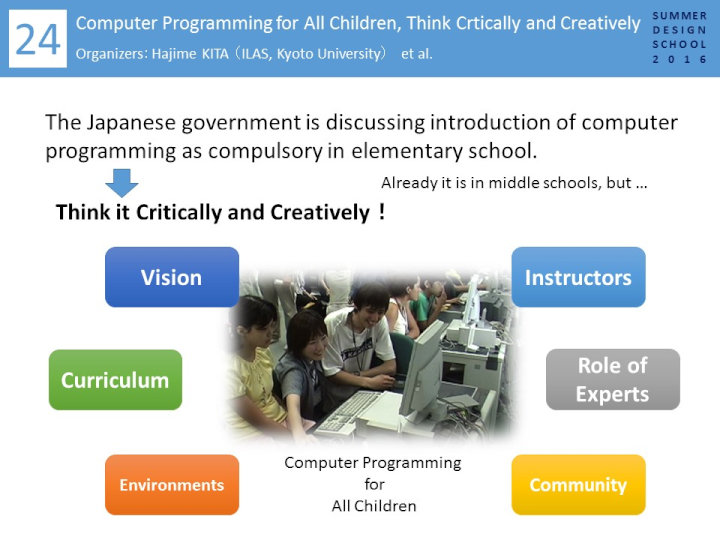Think Critically and Creatively
This theme discusses critically, from various viewpoints, the issue of ‘making computer programming compulsory in the elementary school curriculum’ as planned by the Japanese government. It develops a vision to be achieved, and tries to find creative solution(s) to the issues involved.
| Name | Organization | Specialty |
|---|---|---|
| Hajime Kita | ILAS, Kyoto University | System Engineering |
| Ian Piumarta | Colleage of Information Science and Engineering,
Ritsumeikan University |
Computer Science |
| Kim Rose | Viewpoints Research Institute | Media Development, Cognitive Science |
As part of its strategy for growth, the Japanese government is disucussing the introduction of computer programming as a compulsory subject in the elementary school curriculum. Computer programming is already compulsory in the middle school curriculum, but the way it is taught has several problems such as ability of teachers in programming and content actually taught. This theme will consider, critically and creatively, the issue of ‘Computer programming for all children’. That is, what is the vision for society and for children's learning? What policies do we need to implement to attain this vision? What should experts, such as computer scientists and educators, do for it? What can we learn from the experiences of pioneers such as Seymour Papert, Alan Kay, and Mitchel Resnick?
Through critical and creative discussion on the issue of ‘making computer programming compulsory in the elementary school curriculum,’ participants will experience systematic thinking including various viewpoints of stakeholders, and problems in implementing the policy.
Kita will explain the national curriculum of schools, and the actual situation of informatics education in schools. Kim Rose will talk about her experiences in math and science education using Squeak Etoys and other software.
Ian Piumarta will talk about his experiences learning computer programming as a child and then teaching others the skills involved, including the most essential skills of creative, critical, and algorithmic thinking.
Introspection, reflection, research, brainstorming, prototyping.
- Posing of the problem by Kita, lecture talks by Kim Rose and Ian Piumarta, and research of related information.
- Hands-on experience of several programming environments for children.
- Through brainstorming examine the problem from viewpoints of various stakeholders.
- Propose “Computer Programming for All Chidren” as a future vision.
- Discuss possible approaches to realize the proposed vision.
- Discuss possible approaches to realize the proposed vision, and prototype important parts of the proposal.
- Prototyping of important parts of the proposal.
- Prepare for presentation (KRP)
- Present workshop results (KRP)
